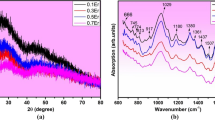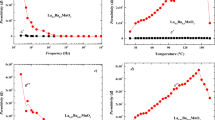Abstract
Tin is not a major constituent of window glass, but is found at high concentrations in the lower surface of float glass which has been in contact with the molten tin bath. It does not extend far into the surface, but causes the physical and chemical behaviour to differ from that of the upper surface. It is important, therefore, to understand the structural role of tin in silicate glasses and thus its effect on various properties. Mössbauer spectra were taken of three series of glassy materials, namely binary glasses (SnO and SiO2) in varying proportions, re-melted float glass containing tin, and float glass from a production plant. The binary glasses contained between 20 and 70% tin which was found to be mainly Sn2+, with very small amounts of Sn4+ in some of them. The spectra showed a small decrease in isomer shift with increase in tin content, which is ascribed to the change in molar volume. The re-melted samples were float glass which was mixed with stannous oxalate in appropriate conditions to try and maintain tin in the 2+ state, and contained up to 15% tin by weight. The spectra show both Sn4+ and Sn2+ with rather more in the 4+ oxidation state. The change in the spectra as a function of temperature revealed a large difference in thef-factor (and hence the chemical binding) of the two states. A series of spectra was taken between 17.5 and 900 K for the sample containing 15% tin. From the absorption as a function of temperature thef-factor was determined for both oxidation states, and hence enabled the relative amounts of Sn4+ and Sn2+ present in each sample to be estimated. Measurements of the shift as a function of temperature were also made. The float samples were surface material produced by grinding away all but 0.1 mm of the lower surface of industrially produced float glass. The Mössbauer spectra showed them to be predominantly Sn2+, as expected from the reducing atmosphere in the float plant. The concentration and oxidation state of the tin may be estimated from the value of thef-factors and isomer shifts.
Similar content being viewed by others
References
G.S. Collins, T. Kacknowski, N. Benczer-Koller and M. Pasternak, Phys. Rev. 19 (1979) 1369.
J.M. Williams, S.D. Forder and J.O. Isard, in:Structure of Non-Crystalline Materials, eds. P. Gaskell et al. (Taylor and Francis, London, 1983) pp. 221–233.
G. Principi, A. Maddalena, A. Gupta, F. Geotti-Bianchini, S. Hreglich and M. Verita, Nucl. Instr. Meth. B 76 (1993) 215.
D. Holland, M.M. Karim, C.E. Johnson, K. Williams and J.A. Johnson,Fundamentals of Glass Science and Technology, Supp. to Revista della Stazione Sperimentale del Vitro, Vol. XXIII (1993) pp. 223–228.
M.M. Karim, PhD Thesis, University of Warwick, UK (1994).
Author information
Authors and Affiliations
Rights and permissions
About this article
Cite this article
Johnson, J.A., Johnson, C.E., Williams, K.F.E. et al. Mössbauer spectra of tin in float glass. Hyperfine Interact 95, 41–51 (1995). https://doi.org/10.1007/BF02146304
Issue Date:
DOI: https://doi.org/10.1007/BF02146304




